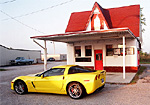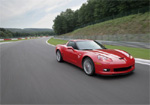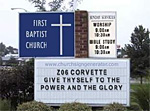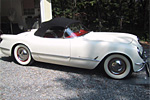Our friends over at DigitalCorvettes.com have now dedicated an entire category to the rumors swirling around a brand new Corvette model. The new model, referred to as the Corvette Super Sport, will sport an LS9 supercharged small block that will output around 600 hp. GM of course is denying the SS story the same as they did the Blue Devil rumors a few months ago. If you recall, the Blue Devil stories also featured a supercharged small block. Up until this weekend, the rumors were just that. But recently a DC forum member posted documents (with CIA like blackouts) that give credence to the LS9 Super Sport Story. These documents, which may be coming from a supplier, shows a proposed timeline of the LS9’s development as well as the replacement of the Z06’s LS7 7.0L 505 hp engine to the LS8’s 480-500 hp engine. Yes, these are rumors and like most can usually be dispelled quickly. But DigitalCorvettes.com and its members have broken the GM Shroud of Secrecy before and past rumors have come to fruition so stay tuned.
The Z06 on the Mother Road
 It’s a trip most Corvette enthusiasts only dream about. The Mother Road, Route 66, stretches more than 2,000 miles from Chicago to Santa Monica, CA. While I am too young to remember the television show, the dream of crossing half the United States in a Corvette is something that I vow will one day happen. Until then, I will just have to enjoy the exploits of those who have actually done it.
Bill Baker of Edmund’s Inside Line recently took to the Mother Road in the Mother of all sports car, the 2006 Corvette Z06. Reading his story, I find myself imagining I am riding shotgun as he is crossing California’s Mojave Desert:
It’s a trip most Corvette enthusiasts only dream about. The Mother Road, Route 66, stretches more than 2,000 miles from Chicago to Santa Monica, CA. While I am too young to remember the television show, the dream of crossing half the United States in a Corvette is something that I vow will one day happen. Until then, I will just have to enjoy the exploits of those who have actually done it.
Bill Baker of Edmund’s Inside Line recently took to the Mother Road in the Mother of all sports car, the 2006 Corvette Z06. Reading his story, I find myself imagining I am riding shotgun as he is crossing California’s Mojave Desert:
“… I could see the road ahead was empty to the horizon. I dropped the six-speed gearbox from 6th to 4th and floored it. Like a cathedral pipe organ playing Bach’s “Toccata” with all the stops out, the 7.0-liter, 505-hp LS7 V8 began to thunder and howl toward its 7,000-rpm redline. The dual-stage mufflers opened to release back pressure and a soul-stirring roar that echoed off the mountains. The head-up digital speedometer and tach display changed numbers faster than a premium gas pump totals dollars. 105, 118…think, look, stay on it. 139 — the front end is feeling light over the rough pavement. Stare at the horizon ’til your eyes harden — and keep your foot planted. 145…flick your eyes for an instant to check the HUD. 154 mph. Things are beginning to blur… there’s a slight rise loomin…”Bill offers an excellent account of not only the Z06, but of Route 66 as it exists today. Today’s Route 66 features a mix of Historic signs, museums and restored buildings with their classic neon signs alongside towns with vacant store fronts and rusting relics. Bill, thanks for the ride… Click here to read the entire article. (Photo Credit Bill Baker)
Z06 in a Class of Its Own
Canadian automotive journalists have been raving about the new Corvette Z06 so much that when it came to handing out their annual end of the year awards, they gave the new Chevy super car it’s own category. The Automobile Journalists of Canada (AJAC) announced creation of a new award to recognize a “truly exceptional vehicle that sets new standards” and presented the inaugural “AJAC Most Coveted Vehicle” award to General Motors of Canada. Richard Russell, President of AJAC, said “Every once in a long while, a vehicle comes along that stirs the hearts and minds of automobile enthusiasts. Often, it stands apart from the pack and in some cases has no competition at all, let alone in a category created for the annual AJAC award”. While this is a new award, it is one that would be handed out only on rare occasions where cars like the Z06 truly separate themselves from their competition. Hattip: The Auto Channel.
Corvette Makes 10 Fastest List
 Think the Z06 Corvette is the fastest American-produced automobile? At a top speed of 198 mph, the Z06 is certain to be the fastest American car to be produced in mass quantity, but in terms of pure speed, there are 4 other American sportscars whose top speed ranks before it.
Forbes.com has compiled a listing of the fastest American cars using the top-speed data listed by the manufacturer. The list only allows room for one nameplate so the Z06 makes list but the coupe and convertible models, which both boast a top speed of 186 mph do not make the list.
Cars that make up the 10 Fastest List in order are:
No. 1 SSC Ultimate Aero. Base Price: $654,500 Top Speed: 260 to 273 mph
No. 2 Saleen S7 Twin Turbo. Base Price: $555,000. Top Speed: 240 to 260 mph (estimated)
No. 3 Evans 387 and 487 (tie) Base Prices: $175,000 (387); $170,000 (487) No. 4 Ford GT
No. 4 Ford GT. Base Price: $141,245 Top Speed: 205 mph
No. 5 Chevrolet Corvette Z06. Base Price: $65,800 Top Speed: 198 mph
No. 6 Dodge Viper SRT-10. Base Price: $85,745. Top Speed: 190 mph (estimated)
No. 7 Mullen M-11 with V-8. Base Price: $69,950 Top Speed: 180+ mph
No. 8 Panoz Esperante GTLM. Base Price: $121,325 Top Speed: 180 mph
No. 9 Chrysler 300C SRT8, Dodge Charger SRT8 and Dodge Magnum SRT8 (tie) Base Prices: $42,695 (300C), $38,095 Charger) and $37,995 (Magnum) Top Speed: 165 to 170 mph (estimated)
No. 10 Cadillac CTS-V. Base Price: $51,395 Top Speed: 163 mph
What Forbes.com says about the Corvette Z06:
Think the Z06 Corvette is the fastest American-produced automobile? At a top speed of 198 mph, the Z06 is certain to be the fastest American car to be produced in mass quantity, but in terms of pure speed, there are 4 other American sportscars whose top speed ranks before it.
Forbes.com has compiled a listing of the fastest American cars using the top-speed data listed by the manufacturer. The list only allows room for one nameplate so the Z06 makes list but the coupe and convertible models, which both boast a top speed of 186 mph do not make the list.
Cars that make up the 10 Fastest List in order are:
No. 1 SSC Ultimate Aero. Base Price: $654,500 Top Speed: 260 to 273 mph
No. 2 Saleen S7 Twin Turbo. Base Price: $555,000. Top Speed: 240 to 260 mph (estimated)
No. 3 Evans 387 and 487 (tie) Base Prices: $175,000 (387); $170,000 (487) No. 4 Ford GT
No. 4 Ford GT. Base Price: $141,245 Top Speed: 205 mph
No. 5 Chevrolet Corvette Z06. Base Price: $65,800 Top Speed: 198 mph
No. 6 Dodge Viper SRT-10. Base Price: $85,745. Top Speed: 190 mph (estimated)
No. 7 Mullen M-11 with V-8. Base Price: $69,950 Top Speed: 180+ mph
No. 8 Panoz Esperante GTLM. Base Price: $121,325 Top Speed: 180 mph
No. 9 Chrysler 300C SRT8, Dodge Charger SRT8 and Dodge Magnum SRT8 (tie) Base Prices: $42,695 (300C), $38,095 Charger) and $37,995 (Magnum) Top Speed: 165 to 170 mph (estimated)
No. 10 Cadillac CTS-V. Base Price: $51,395 Top Speed: 163 mph
What Forbes.com says about the Corvette Z06:
The newest Corvette is also the fastest Corvette ever. Recently released, the Z06 has about as low a sticker price as a car with 505 hp can have. The Z06 performs like a race car or supercar, but is also a perfectly acceptable “daily driver.” Consider its fuel economy: 16/26 city/highway mpg–hardly typical for a race car.
Corvette’s Tom Wallace Q & A
New Chief Engineer Talks About Racing, Restoring and Teaching Respect for Automobiles
On Jan. 1, 2006, Tom Wallace will officially become the car guy with the best job in the world. On that date he will succeed Dave Hill as Corvette chief engineer and vehicle line executive (VLE) for performance cars. Wallace will become only the fourth person to carry the title of Corvette chief engineer in the marque’s history, joining an exclusive club whose membership includes Zora Arkus-Duntov, Dave McClellan and Hill. As the head of the Corvette Nation, Wallace will become the steward of the Corvette legend and the head of an extended family of Corvette enthusiasts, owners, collectors and racers. He is the right gearhead for the job, with more than 30 years of experience as a hands-on builder, restorer, race car driver, and all-around car nut. Wallace, 57, was born in Pittsburgh. He began his GM career as a cooperative student with Buick Motor Division in 1970. He held several engineering positions focusing on engine technology and played a key role in the development of the turbocharged Buick Grand National coupes of the early ’80s. Wallace most recently was vehicle line executive for Small/Midsize Trucks. After competing in amateur drag racing and gymkhana, Wallace started road racing with the Sports Car Club of America more than 30 years ago. He has competed in a variety of sedan and GT classes with raced-prepared Oldsmobile, Buick and Chevrolet models. He raced professionally in the International Motor Sports Association (IMSA) American Challenge series in 1978-79 in several endurance races, including the Sebring 12-hour and Daytona 24-hour events. Wallace now races regularly in the Detroit area and has twice won the GT1 championship at Waterford Hills Raceway. He has competed in the SCCA National Championship Runoffs six times. His sons, Brian, 35, and Tom, 38, are avid road racers who also have competed the SCCA Runoffs. In the following Q&A, Wallace discusses racing’s impact on both individuals and auto manufacturers. How does your racing experience influence your approach to your new position as Corvette chief engineer?
The one thing that racing absolutely drives is discipline in timing. When they call the cars to the starting grid, you can’t say, “Hold on, I need some more time.” You can’t let it slide; you have to look at the end point and plan your work to be completed before grid time. The second is the need for balance in the product. You can have a great motor, but if your chassis doesn’t work, it’s not a good race car. If you don’t have a good driver, a good crew chief and a good crew, it doesn’t work. If you run out of money and can’t buy tires, you’re done. You must balance all of the components. It really is critical to understand you can’t allow one thing to override the whole vehicle. Last but not least, you learn it’s no fun to finish second. Winning is everything in racing and in the marketplace we’re in today.How does racing impact production vehicles?
Dave Hill and his team have done an awesome job with the sixth-generation Corvette. I’ve been fortunate to drive an early production Z06, and it’s one incredible vehicle. First and foremost, we’ll continue to build on this strong foundation by continuously improving the current vehicle and developing the next generation Corvette. I like performance vehicles, I drive them and I own them. I race fast cars so I understand what it takes to make a vehicle feel good, how it’s connected to the driver. I don’t mean we’re going to build race cars, but there is definitely cross-over from racing to production. For example, how does the brake pedal feel relate to how the vehicle decelerates? A race car has exceptional brake pedal feel, and the driver knows he has complete control of stopping of the vehicle. That brake pedal feel may be too touchy for the street, but you can start there and dial it back to where it’s right for everyday driving. Another example: good on-center steering feel is absolutely essential in a race car. To go fast in road racing you must hit the apex within inches every time. The only way you can hit the apex accurately is to have steering with such excellent on-center feel that you know exactly where the front wheels are. Customers who drive on the street also want great steering feel when they’re driving down the highway. The vehicle doesn’t wander, and when they see a pothole, they know exactly how much input they need to drive around it.How did you start in racing?
When I was in high school, I loved racing and fast cars. I don’t know where that came from, perhaps from one of my grandfathers who was mechanically inclined. I was fortunate to get a degree in mechanical engineering from General Motors Institute and started my career at Buick. A few months after I moved to Michigan from Pittsburgh, I bought a ’67 RS Camaro. It didn’t have a radio or air conditioning, but it did have big disc brakes, a four-speed transmission and a 4:10 rear axle. I drag raced it for a while, did some gymkhana, and finally decided to go road racing.What is the appeal of road racing?
When I was drag racing, I put in hours and hours of effort to make three or four 14-second runs. I didn’t like off-road rallying with a car, and I didn’t own a truck. Then I did some gymkhana races in parking lots, going around pylons, and that really interested me. My Camaro was 18 inches above the ground when I was drag racing, and then I had it slammed on the ground for gymkhana. This was my family car that I drove to the grocery store, and I torched the fenders and flared them to fit bigger tires. I liked that kind of driving, so I decided to try wheel-to-wheel racing. I went to a couple of driving schools and I got hooked. That’s what I’ve done ever since.And you passed on this interest in racing to your sons?
I don’t know whether it was intentional, but it happened. When my sons Brian and Tom were young, they were interested in cars. They came out to the garage and helped me, and I started to teach them. By the time they were eight or nine, they crewed for me on the race car. Years later they went to Phoenix with me on a business trip and we found two rust-free Camaros that we could restore. We brought them back to Michigan and restored them as a family project, and to this day they both have beautiful Camaros.What did you teach your sons through their involvement with automobiles?
One of a parent’s worst fears is that a young driver will be hurt in a highway accident. I didn’t have that worry because my sons had so many hours invested in their cars that they would never do something foolish. They had learned respect for their automobiles. They also learned that you have to pay attention to details and to strive for perfection if you want to be successful in racing. Those are traits that carry over into the rest of life.What is it about Corvette that excites enthusiasts?
It’s the American sports car icon. There is some formidable competition, but Corvette has been around the longest, it offers the best value and the best balance. Corvettes are fast, and enthusiasts appreciate performance. When I attend races and see hundreds of cars in the Corvette Corrals, I’m in awe. I’m going to spend a lot of time with Corvette owners because they have red Bowtie blood in their veins. Corvettes have always raced, but Corvette wasn’t officially in racing until 1999. What’s the importance of having Corvette Racing competing as a factory team? Before the formation of Corvette Racing, much of the factory racing support had a very low profile. It was helpful, but it wasn’t as effective as a true factory-backed team. I think that today’s Corvettes are absolutely better because we are officially connected with the race team. I intend to do everything it takes to ensure that Corvette continues to be the icon for the American sports car.Is being the Corvette chief engineer a dream job, something you imagined as a teenager?
Being a gearhead, Dave Hill and I had a great relationship. We’d bounce ideas off each other, and he’d ask me to drive an engineering development car for a few days and give him my opinion. Even before getting this job I was driving a Z06 because he knew I’d drive it hard. So yes, it’s a dream job, and it’s still sinking in how awesome it is.What’s your current race car project?
I had a tube-framed GT1 Camaro that we raced in SCCA. My crew chief, Mike Begley, and I built it identical to a Trans-Am car, about 2300 pounds with 700 horsepower. I just sold that because we are building a new car, and just coincidentally, it’s a Corvette.Will your new job responsibilities cut into your track time?
I certainly hope not, but if they do, so be it. It may take some time for me to get integrated with the Corvette group, but I’m not going to cut out track time completely from my schedule.
NCM Modified Corvette Exhibit
The kick off of the National Corvette Museum’s 2006 display season will feature a special “modified Corvette” theme, recognizing Corvettes that have been externally modified. The NCM is looking for members who own modified Corvettes to contact Betty Hardison at: [email protected] or 800 538 3883 x141 for more details on submitting a Corvette for this special display. Visit the National Corvette Museum.
Corvettes on TV
Thanksgiving always brings back memories of hitting the road (over the hills and through the woods) to visit family and partake in Thanksgiving feasts and this year will be no different as my family heads out on a nearly 2,000 road trip from Florida to Kentucky. Unfortunately, no visit to the NCM will be made during this trip, but we will be attending the UK vs Tennesse football game on Saturday in Lexington. While I’m gone this week, I won’t be doing any posts to CorvetteBlogger.com, however my TiVo will be very busy.
SpeedTV is offering several shows that focus on the Corvette or muscle cars in general. Here is what is on my list:
Old School Corvette Racer
SpeedTV – Thurs, Nov. 24th
Tom, Peter and the rest of the Dream Car Garage crew build a vintage racer from the junked remains of a ’69 Corvette and go racing.
Small Block Shootout
SpeedTV – Thurs, Nov. 24th
From the producers of Dream Car Garage, Small Block Shootout features four small block pony cars, representing the street versions of the legendary Trans-Am cars that battled it out on road courses across North America during the 1969 and ’70 seasons.
American Muscle Car is running a marathon on Friday. Two of their shows include:
The Mako Shark and Beyond
SpeedTV – Fri, Nov 25th – 1pm
America’s first sports car is 47 years old and still going strong. Okay, so the program is a little dated, but that is the beauty of classic corvettes – they never change!
The Man Who Invented the Small Block
SpeedTV – Fri, Nov 25 – 10PM
Ed Cole’s quest to create Chevy’s first V8 engine transformed Chevrolet’s from low-buck transportation into the raciest cars ever made in Detrot.
What Would Jesus Drive?
 Okay, I admit that Jesus probably wouldn’t be driving a Corvette. And even if he did it would probably be a Convertible, not the 505 Beast. I see him more as a sedan type fellow anyways. Maybe toolin around town in an Impala SS. Hey, gotta have some room for the flock, right?
I came across the Church Sign Generator while visiting Joe Sherlock’s The View Through The Windshield. And while the Z06 reference is the first thing that came to mind, I am sure that by tomorrow I’ll come up with half a dozen more.
I hope I don’t go to hell for this post so I’ll try to make it a little fun. Leave a comment on what year/model of Corvette you think Jesus would drive and why. The one I like the best wins a free Corvette Price Guide – A $15 Value!
Okay, I admit that Jesus probably wouldn’t be driving a Corvette. And even if he did it would probably be a Convertible, not the 505 Beast. I see him more as a sedan type fellow anyways. Maybe toolin around town in an Impala SS. Hey, gotta have some room for the flock, right?
I came across the Church Sign Generator while visiting Joe Sherlock’s The View Through The Windshield. And while the Z06 reference is the first thing that came to mind, I am sure that by tomorrow I’ll come up with half a dozen more.
I hope I don’t go to hell for this post so I’ll try to make it a little fun. Leave a comment on what year/model of Corvette you think Jesus would drive and why. The one I like the best wins a free Corvette Price Guide – A $15 Value!
Corvette Values: 1972 Convertible
Neal B. sent us the following email: Hi, I am in the process of restoring a 72 convert. The car came with a m21 close ratio 4sp and no other options. It is steel Cities Gray. Is the tranny rare for a 1972 and is the steel cities gray rare. The reason I ask is, I don’t particularly like the color (blue is my color). However, I may sell it when it is finished and I want to get the most out of it. Thanks Neal Our Response: There were three transmission options available in 1972: the base wide ratio 4-speed, the Turbo Hydra-Matic Automatic and the M21 Close Ratio 4-Speed. The M21 was installed in just 1,638 Corvettes out of a total production of 27,004 making it an option in just 6% of the Corvettes produced in 1972. There were 10 exterior colors available in ’72 and the steel cities gray was selected in 2,346 Corvettes or just over 8% of total production. Because there so many colors offered in 1972, this doesn’t add any real value to your Corvette. If your ’72 is numbers matching but the exterior color is different than original, you may take a slight hit in the value of the Corvette. You can minimize that hit by going with a color from the same year. If you decide to repaint it blue, go with Bryar Blue, offered only in 1972 on 1,617 total Corvettes: http://www.corvetteimages.com/index.cfm?fuseaction=image&id=14946 Our current price guide shows an average 72 Convertible valued at $21,600 with a one year appreciation of 12%. The 68-72 models have been showing tremendous value over the last few years and that trend will probably continue.

